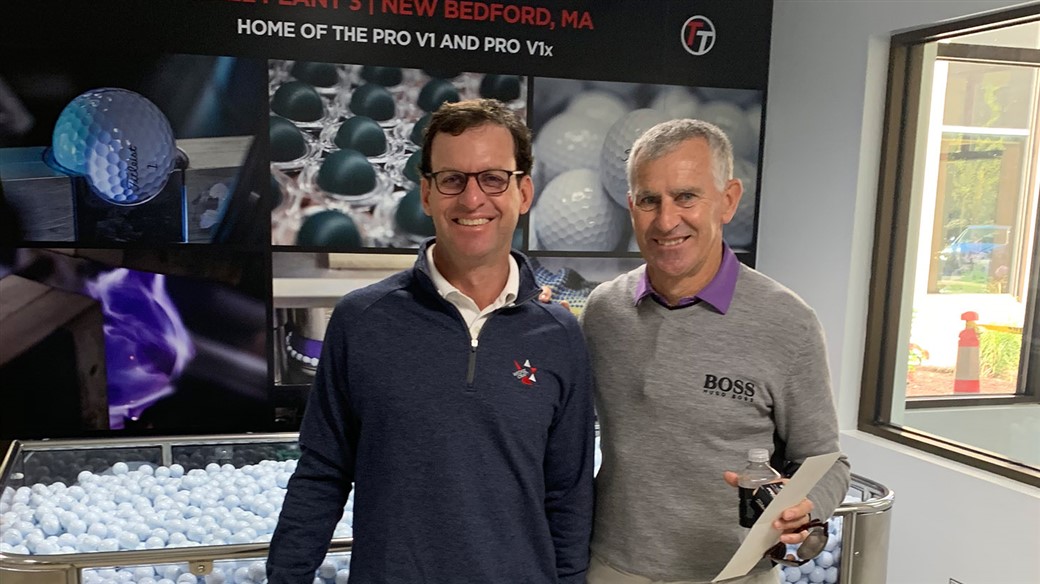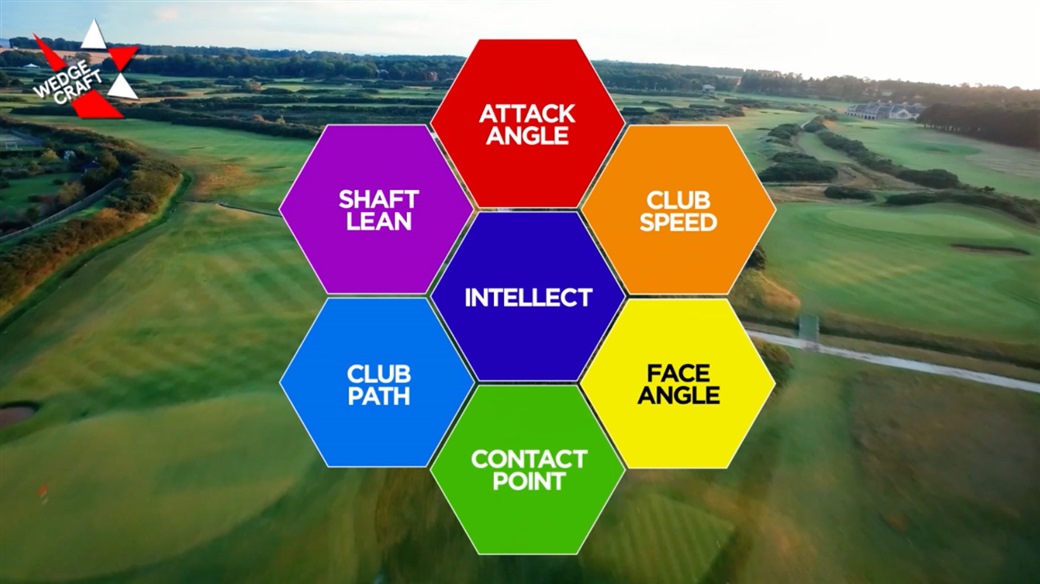Hey, Team Titleist!
I want to share an exclusive Team Titleist experience with you that I was lucky to take part in recently. A couple of weeks ago, Doctor Rob Neal and Layne Savoie, the co-founders of WedgeCraft, paid a visit to Titleist. WedgeCraft is a data collective that applies state-of-the-art technologies (including 3D motion capture, TrackMan Launch Monitor tracking and high speed video) to study wedge play and the best wedge players in the world. The result of their 6-year research is a vast database of information that can now teach us all what’s really going on in the short game.
Doc and Layne have been great partners and valuable contributors in our effort to provide more instructional content on Titleist.com. I hope you’ve all seen the brilliant short game tips that Doc and Layne have shared with us over the past year. In case you've missed them, please check out the links to their videos that I've included at the bottom this article.
Layne and Doc kicked off their visit bright and early with a tour of our Ball Plant 3 operations. They also visited Titleist headquarters and met with some of our lead scientists and engineers in Golf Ball R&D. I tagged along during both tours and was struck by their thoughtful questions and how curious they both were about the golf ball. I would learn later that everything is research for WedgeCraft, as equipment (both the ball and the wedge) has a profound impact on short game performance.

A Discovery About Wedge Technique
After a busy morning, we took a short drive from Fairhaven to Acushnet, Mass., for the main event – a short game experience that Doc and Layne suggested we arrange exclusively for Team Titleist members. As we pulled into the parking lot, Mike D. and Karen Gray (Supervisor for Player Testing) were guiding eight lucky Team Titleist members on a tour of our Manchester Lane Test Facility – a perfect diversion as Layne, Doc and I made our way to the Short Game area and set up for their half-day master class.
Following a brief welcome and a proximity game that served as a warm up, Doc and Layne invited our guests (TT members Jim K., Jay R., Mike C., Tom M., David K., Josh G., Ted L. and Brian D.) under a nearby tent for an overview of their findings and how they have used all that data to better understand short game skill and technique.
One of the most enlightening discoveries their data bore out is that the best wedge players in the world lean the shaft forward at impact. This goes for finesse shots as well as distance wedges. As Doc shared with the group, this information was met initially with a lot of resistance, as it flies in the face of the conventional teaching that the shaft must be vertical in order to use the bounce properly. So why aren’t the best wedge players doing what we thought they should be doing? Simple. Shaft lean creates more friction between the ball and the club face, boosting rpm's and increasing the odds of getting up and down.
The Short Game Spin Equation
Shaft lean is just one aspect of good technique and to generate tour-caliber spin we actually need two other key ingredients - a good golf ball and a good wedge. Dr. Rob explained that premium performance golf balls like Pro V1, Pro V1x and AVX offer a measurable advantage over lesser balls due to their cover material, urethane elastomer, which is soft, pliable and allows for maximum friction between ball and club face at impact.
How much more? WedgeCraft’s research showed that on a 75-yard shot with a new Vokey SM6 (58°), the Pro V1 came off the face of the wedge with 8,300 rpm of spin. Under the same exact conditions, a top-selling Surlyn-covered 2-piece ball had only 5,600 rpm of spin. Because of that additional friction, the Pro V1 also launched significantly lower (26° vs. 31°), which is a key hallmark in the way that tour players play full wedge shots.
The wedge itself is obviously important, too, and Doc and Layne came to the clinic armed with a full array of brand new Vokey SM7 wedges. In their testing, Doc and Layne compared experienced wedges (70 rounds played) to new wedges. In perfectly dry conditions, off an artificial mat, the Pro V1 launched a degree higher, but still spun more than 8,000 rpm. In contrast, the two-piece Surlyn ball launched four degrees higher and only had 3,000 rpm of spin on the full, 75-yard shot. If any moisture were to get between the club face and the ball (as you'd experience on the golf course), the numbers would be dramatically worse.
In the clip below, Layne talked about the importance of fresh wedges:
After the overview session, Doc pointed to two stations that he and Layne had set up out in the fairway for 20-yard pitch shots. Layne and Doc filmed each of our guests and recorded the ball flight data for this standard, square-faced pitch. For the following hour or so, Layne and Doc used this baseline information to recommend technique changes and prescribe courses of action for our players going forward.
- And in this clip, Rob demonstrates the connection between face angle and swing path.
As Doc said at the very beginning of the clinic, it’s far more effective to hit shots than to talk about them, so after every player had been evaluated, it was time to dive into the key elements that must be controlled and manipulated properly in order to hit the infinite variety of finesse wedge shots that game asks of us. After distilling the results of their study, Doc and Layne arranged these seven elements into a framework that they refer to as the CONTROL VARIABLES. These variables are:

A Baseline Solution for Finesse Wedge Shots
Angle of Attack is at the top of the hierarchy in the WedgeCraft model for a couple reasons. It’s difficult to control the angle at which the club approaches the ball. It’s difficult to train properly for this variable. And it is has a profound impact on the outcome of the shot if you miscalculate it.
Doc and Layne explained that for the majority of golfers (and for most of our clinic participants), coming into the ball too steeply is the main cause of inconsistency. To address this, they developed what they call a baseline technique for finesse wedges. It’s a way to set up to the ball and move the club with the body turn that promotes a more shallow angle of attack. This provides greater margin for error and this basic technique allows you to adjust the other control variables to hit a wide variety of finesse shots. Layne and Doc provided an overview of this technique in the following video:
The Right Tools for the Job: Pro V1 and Vokey SM7
The WedgeCraft Experience ended with one final surprise. Jay R. had recorded the highest score during the warmup proximity game and for his performance, Mike D. announced that Jay would be the proud owner of new custom Vokey SM7 wedge. True to form for Mike, however, he also announced consolation prizes for all our other attendees - custom Vokey SM7 wedges! Along with the fresh Pro V1 and Pro V1x's from their gift bags, our guys will be 2/3 of the way towards tour-level short games!
I can’t thank Layne and Doc enough for making the trip to Massachusetts and sharing their expertise. I learned so much just observing and it was really rewarding to see the progress that our Team Titleist players were making by the end of the afternoon. I only wish I had the foresight to schedule Doc and Layne for a full day.
If enough TT members are interested, we may just have to look into that…
I also have to thank Allan B., Mike D., Rich Daprato and Karen Gray for all their help in coordinating the day's events. It was a truly unique program and a great example of the benefits and surprises you can only experience as a member of Team Titleist.
To learn more about Layne and Doc and the wealth of wedge play knowledge they’ve assembled, please visit WedgeCraft.com.
For more short game instruction from Layne and Dr. Rob, check out the links below and be sure to keep an eye out for their next instructional tips on Team Titleist!
One Arm Wedge Training
Towel Drill
Quick Fix: Using the Bounce
Trail Arm Wedge Training-String Drill
U.S. Open Tips: Hitting a Flighted Wedge Shot on No. 7 at Pebble Beach
Finesse Wedge Fundamentals- Head Rotation at Impact
#TeamTitleist